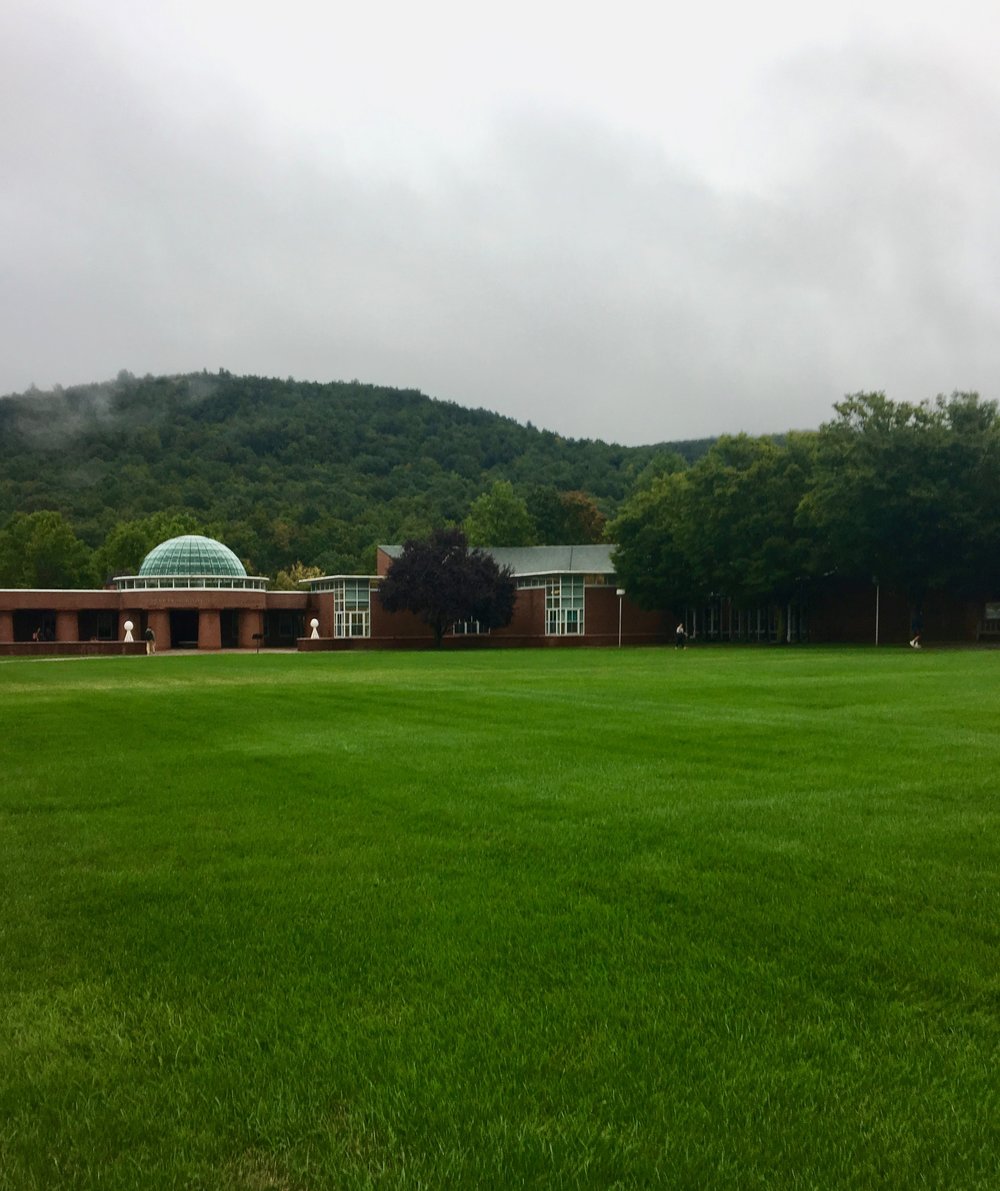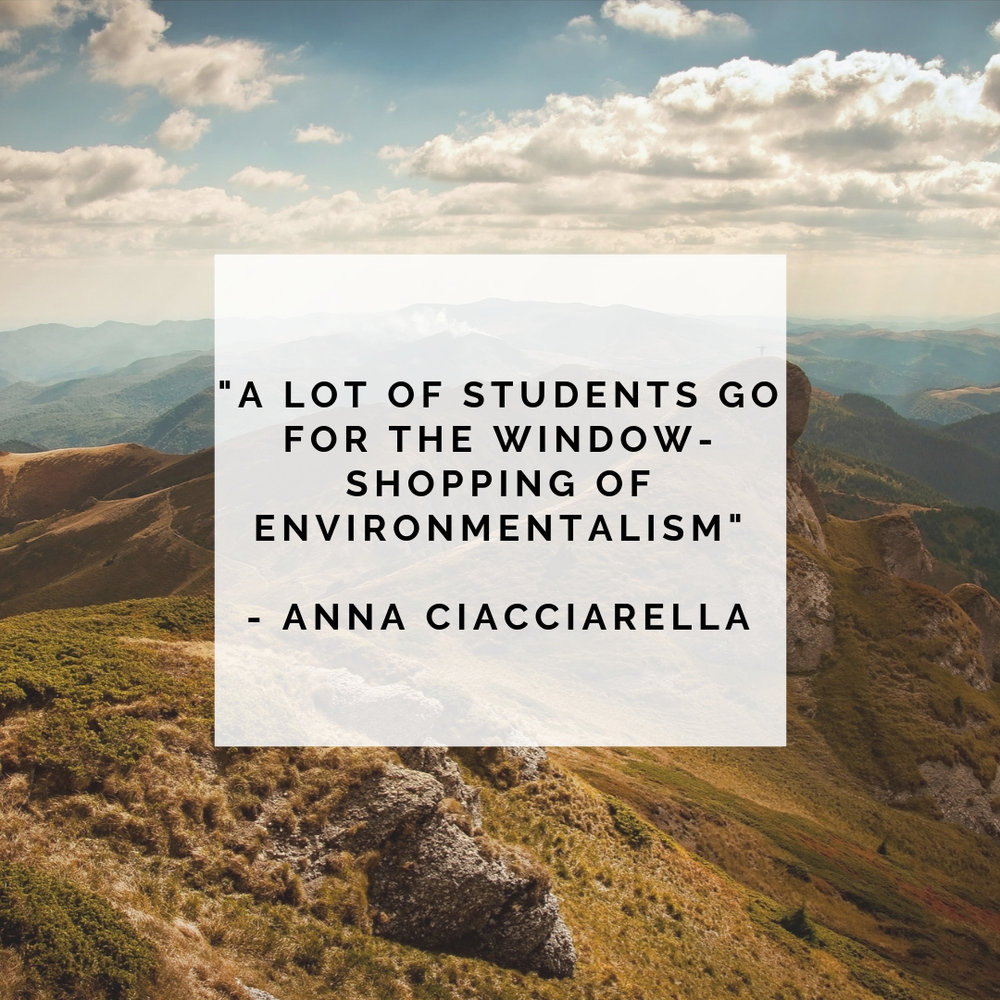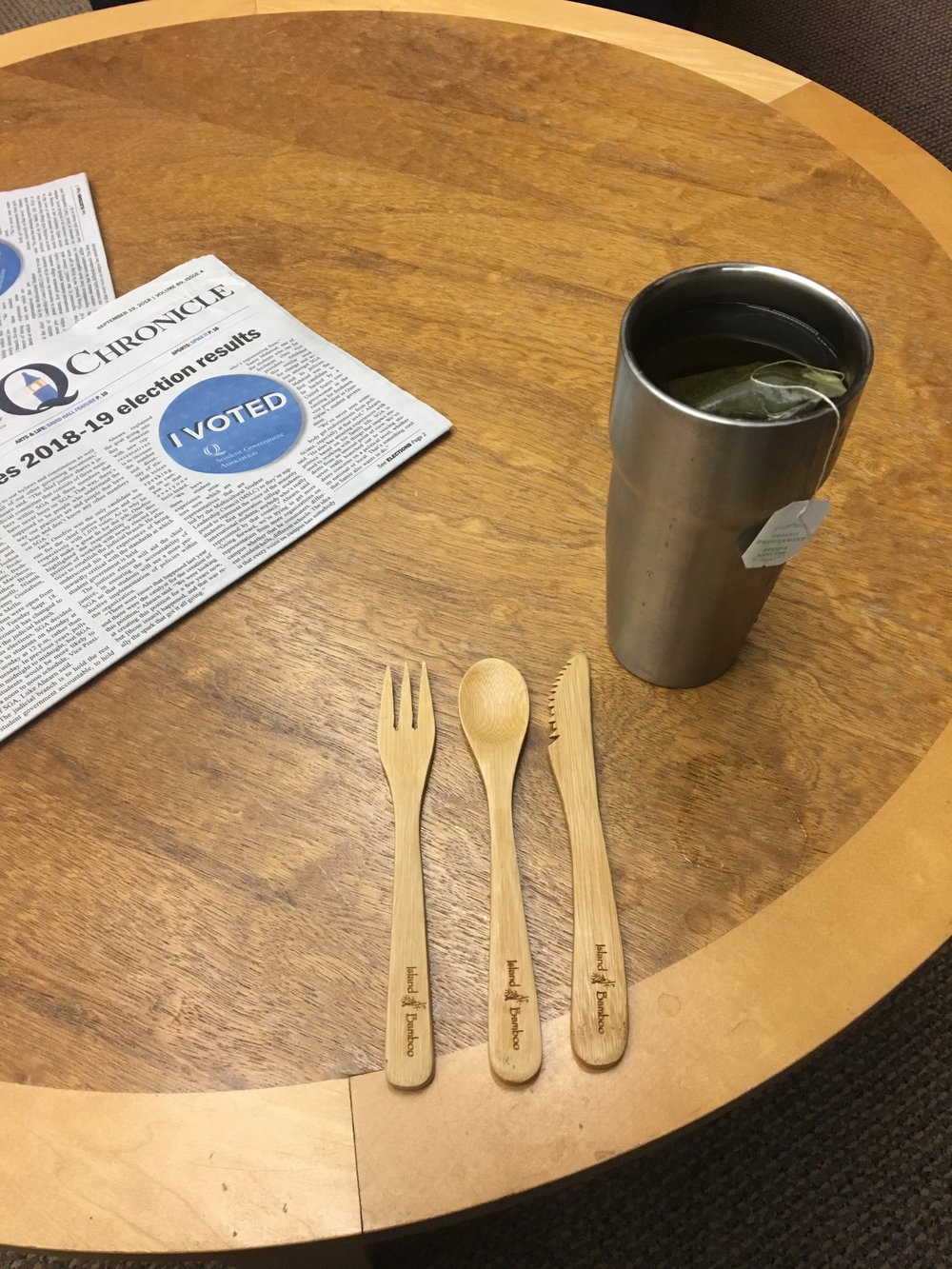By Ana Grosso

College is a place of innovation, thought development and self-awareness, making it the perfect environment to educate students to fight back against climate change. But often, students’ day-to-day priorities overshadow our environmental consciousness. With the constant on-the-go lifestyle and busy schedules, student waste goes overlooked and sustainability takes a back seat.
Erin LeDrew, senior sociology major and vice president of Students for Environmental Action (SEA), set out on a mission to see just how conducive to waste the college lifestyle can be. LeDrew’s experiment, called “A Week Without Waste,” attempted to reduce the amount of paper and plastic that college students rely so heavily upon.
“I would say the biggest challenge was, especially living on York last year, they don’t have anything reusable,” LeDrew said.
Quinnipiac University’s York Hill campus only has plastic and paper forms of dish and silverware, “So, if I was reusing anything, I was bringing it from my dorm,” she said. “I definitely got looks. It was definitely a stigma like, ‘what are you doing?!’ but there was literally no other option.”
Even on the university’s Mount Carmel campus, LeDrew had limited options. She could not eat from the sushi or noodle bar as those items only come in plastic, she couldn’t grab any items to go or eat any snacks that came in packaging, or even eat anything that required toppings. The cafe independently packages everything from ketchup to cream cheese and peanut butter to maple syrup. Additionally, whenever LeDrew went to order hot or freshly-made food, she had to remember to ask the server to put it on a ceramic plate instead of the default paper one.
LeDrew brought reusable silverware and dishware with her to campus every day to eliminate single-use plastic waste. “It was so hard when I was busy because there’s no compostable takeaway containers, they’re all plastic,” LeDrew recalled. “I remember running between classes and meetings and unless I could sit down and eat, I wasn’t eating anything unless it was an apple or a banana.”
LeDrew found Coffee, tea, and water the easiest to consume waste-free in the cafe because she brought her own reusable coffee mug and water bottle. However, smoothies, iced coffee and most juices were not feasible because they only came in single-use plastic.

This is an example of two people’s waste from just a quick snack in the café. Multiply this by 7,361 undergraduate students, and those living on campus eat at least three meals per day.

Colleges witness significant spikes in their solid waste at the end of the school year as well, according to Connecticut’s Department of Energy & Environmental Protection.
There are other aspects of the university outside of food waste that challenge just how sustainable this campus is.
Hundreds of students live within just two or three miles of each other, yet the university’s north parking lot is filled to capacity every school day.
“Nobody uses the shuttles and I just wish that people would carpool more, even just going into town or grocery shopping,” LeDrew said. Obviously, students’ schedules do not match up perfectly, but even the minor inconvenience of coming to campus a little early or staying a little later is enough to deter students from carpooling or taking the shuttle.
“Also, why wouldn’t you want to save on gas?!” LeDrew added.
This attitude of indifference perpetuates the lack of sustainability at Quinnipiac, and creates a stigma around environmental consciousness.
“I honestly think that Quinnipiac as a whole is extremely wasteful in most ways,” LeDrew said. “Just for example, I heard a girl complaining about how the default on printers is double-sided. She likes when they’re printed single-sided and doesn’t want to have to choose the option to print single sided.”

A company called Resonate LLC. conducted a Campus Culture Report in 2014. In the report, the company wrote, “We sometimes heard students characterized as uninformed and unengaged. A related perception that we heard is that the student body generally suffers from an attitude of entitlement.”
The combination of student loftiness and poor encouragement lead to a deadly cycle of indifference towards the environment.
“I feel like people really just don’t care here,” Jen Zurek, sophomore nursing major said.
63.7 percent of Quinnipiac students agreed that most students are not really concerned about sustainability issues, according to Resonate.

Indifference is also fueled by convenience and vice versa. Quinnipiac’s staff works tirelessly behind the scenes to ensure an efficient and enjoyable college experience for the students. The rugs and floors are spotless, but there is never a sign of anyone polishing them. The facilities department cleans every student’s bathroom who lives on main campus before they even wake up in the morning. When disposing of dishes in the cafeteria, students simply place all of their dirty dishes, trash, food, and recyclables onto a speedy conveyor belt that whisks away the mess just as quickly as it was created.
But, is environmental consciousness being sacrificed for the sake of efficiency and student service?
“It’s easier to grab plastic water bottles you can just throw out and plastic utensils you don’t have to walk to the conveyor belt for,” LeDrew said, explaining possible reasoning for such environmental indifference.

The grass on the quad is always perfectly groomed, yet one hardly ever sees a lawn mower. In fact, when you look at Quinnipiac’s sprawling Mount Carmel campus, one of the first things you’ll notice is that it looks quite green. Ironically, that “green” look ends up doing more harm than good for the environment because of the water waste and pesticide runoff.
A running joke among students is that no matter what time of year, the grass on the quad is always green. LeDrew heard students lamenting over the fact that the university’s sprinkler system was on during the intense rain storm on Sept. 25 in which Hamden saw seven inches of rain in just one hour.
However, the university actually labels its York Hill campus as the “green” one.
At the summit of York Hill looms 25 cylindrical wind turbines that dominate the grassy mound. However, even on the windiest of days, only one or two rotate ambitiously. Students on campus often wonder what their purpose is.
“Those things have to be broken,” senior Katie Herrick said. “I literally haven’t heard anyone mention them or their purpose since I’ve been here.”
There’s a reason why.
“At the moment, the wind turbines on York Hill are decorations,” said engineering professor John Reap. “Mechanical and electrical problems rendered them incapable of producing power some time ago, and to my knowledge, the university does not have a plan to repair, replace or reconfigure them.”
According to The Quinnipiac Chronicle, “The reason the wind turbines have been almost entirely non-functional since they began to fail is because the manufacturer, Windspire, went bankrupt.”
“Anyone can see for themselves, if you look at the wind turbines on York Hill, they’re never moving,” 3+1 public relations major Leah Lavin said.
The sprawling 250-acre campus was completed in 2010. Reap said that the wind turbines had not been working since before he arrived at the university in 2012. The turbines were originally designed to generate just over 32,600 kilowatt hours per year. That would be roughly enough power to light almost 450 light bulbs for one month.
Other efforts on York’s campus include 1,232 photovoltaic solar panels on the roof of the Crescent Residence Hall. The panels convert energy from the sun to electricity and generate about 250,000 kilowatt hours per year.
“There is so much more room for solar panels not only on York Hill, but all over campus,” Lavin said.
Reap believes that the solar system on York Hill feeds the university’s electrical grid.
Despite those steps, the campus’ cafeteria still uses single-use silverware and dishware.
Resonate LLC.’s report noted that “(t)he QU student body is viewed, by students and faculty alike, as intelligent, but generally unaware of and unengaged with sustainability… We heard several examples of students being unwilling to perform small feats of conservation, such as turning off lights when leaving a room (because ‘I pay $50,000 to go here, so I can leave the lights on if I want.’)”
“People don’t realize that they have an effect on everything,” LeDrew said. “Especially if you’re someone who’s constantly buying way more than you can eat, or just buying plastic water bottles every single day just to get rid of your meal plan.”

Mandatory meal plan is another factor that prompts wastefulness on the university level. “I think that people have no concept of what they’re wasting because a lot of people have $600 left and will just buy whatever they want,” LeDrew said.
Resonate’s Campus Culture Report also stated that, “Students expressed views about fellow students saying, “They don’t recycle at all,” and “In the dining hall, they throw everything away.”
Lavin also noticed that, “The trash cans are not only overflowing with stuff that could have been reusable, but also food that could have been donated or put into a compost system which would be really helpful for our environment.”
Quinnipiac has not drawn much attention to the campus culture reports.
Political science professor Sean Duffy said, “As with many ‘studies,’ this one seems to have lived primarily on a shelf somewhere – it’s never really guided any action on the part of QU.”
Even at a local level, Resonate LLC. noted in its Sustainability-Focused Curriculum Report that, “Other benchmarking metrics show that QU lags behind a majority of the Peers/Aspirants in broad-based sustainability performance recognition, as well as involvement in industry organizations. We note, however, that the Peers/Aspirants have among them some very high performers with respect to sustainability.”
LeDrew would be one of those performers. She interns at the Albert Schweitzer Institute in the
Food Systems & Sustainability division, and is working to change people’s mindsets towards waste. “It’s such a disconnect for people,” she said.
“The Albert Schweitzer institute is a huge advocator for environmentalism on campus, and it’s very much overlooked. Not many people know what it does at all actually,” Lavin remarked. Duffy is the executive director of the Albert Schweitzer Institute and hopes to create an official space there specifically for environmentalism.
One of the things LeDrew is working on at the institute is a hierarchy with food waste. “The idea behind the hierarchy on campus is that the first priority with excess food is donation. The next option is composting or reusing, and disposing is the absolute last resort,” she said. She is also hoping to put a large scale on the wall of the café to make students more aware of the effect their waste has.
LeDrew is not alone in hoping that these efforts come to fruition. Reap chairs the university’s sustainability committee, which has roughly 24 faculty members, but welcomes students as well. At the bi-semester meetings, the members discuss green opportunities across campus such as local farmers markets, the greenhouse on the North Haven campus and composting opportunities on Main Campus.

Perhaps these initiatives inspired the university to further their sustainability efforts. Quinnipiac is offering environmental studies as an independent major this year, and Anna Ciacciarella is taking full advantage. She is a sophomore English & environmental studies double major and on Oct. 3-7, she and fellow sophomore Sabrina Escobar attended the Society for Environmental Journalists conference in Flint, MI.

At the conference, Ciacciarella and Escobar learned how to bring issues of social justice as well as wastefulness to light at a local level. “I think people here feel like they don’t need to care about the environment because it’s not directly impacting them. If they were in a community such as Flint, Michigan, they would be feeling the effects, and they would realize they have to make a difference,” Ciacciarella said. “A lot of students go for the window shopping of environmentalism… but the way we’re going to get things done is with the students realizing we have to make true change, not just change at face value.”
If the university continues to engage students in sustainability efforts, perhaps that would in turn inspire students to engage other students.

